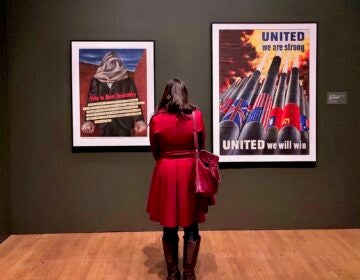Historic Philly prison exhibit focuses on victims, not murderers
At the invitation of Eastern State Penitentiary, artist Cindy Stockton-Moore painted ink portraits of fifty victims.
The old Eastern State Penitentiary once dressed up the cell where Al Capone was incarcerated in the luxury to which the gangster was accustomed. The historic attraction also made a detailed archaeological study of the escape tunnel dug by the notorious bank robber Willie Sutton.
Stories like these have attracted tourists and artists to the crumbling prison, now maintained in a state of suspended decay.
“Part of what’s so special about it is it allow me access to a place you don’t have access to,” said artist Cindy Stockton-Moore. “But my empathy was always with the prisoners, because you’re in that space. Some of these people took other people’s lives.”
At the invitation of Eastern State Penitentiary, Stockton-Moore researched the people murdered by the prison’s inmates, painting ink portraits of the victims.
The earliest was a prison guard, Michael Duran, killed in 1884 by a shank which inmate Jospeh Taylor crafted from a wooden yarn bobbin.
The most recent victim was Patricia Sholley, a 23-year-old nurse who disappeared in 1968 after her shift at Reading Hospital. Her body was discovered a few days later, with bludgeons to the head.
“The inmate convicted of her brutal murder is still incarcerated,” said Stockton Moore. “He is someone the Eastern State tour guides visit in prison to talk about prison life.” The killer, Maurice Talley, is now held at Graterford prison.
Stockton-Moore worked with the prison’s research staff to find the identities of as many murder victims as possible. They discovered hundreds of stories, including a “poison ring” wherein perpetrators would poison new immigrants, then collect insurance money.
However, many murder victims left no photographic record of themselves.
“It followed a really clear pattern of race and economics,” said Stockton-Moore. “Young, white children of a certain economic status, I can find. Other people, not so much. I have only three victims of color.”
Of the hundreds of victims of Eastern State inmates, Stockton-Moore could only find 50 with photographs on record. “If I had a few more months, I could have found maybe 20 more,” she said. In the cell is a ledger on a podium with information on each of the victims.
She painted the portraits on sheets of semi-transparent Dura-lar (similar to Mylar) to survive the prison’s damp climate more effectively, and hung them from the ceiling of a small cell in block 14 of Eastern State Penitentiary. The canopy of images is lit only by narrow strips of overhead skylight.
“As these are semi-translucent, they tend to capture light and glow differently through the day,” said Stockton-Moore. “The light curates different moments with different spotlights.”
WHYY is your source for fact-based, in-depth journalism and information. As a nonprofit organization, we rely on financial support from readers like you. Please give today.










